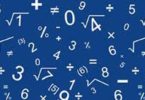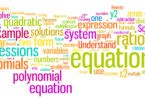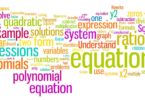MCQ on Matrices and Determinants:
If the system of equations, x + 2y – 3z = 1, (k + 3)z = 3, (2k + 1)x + z = 0 is inconsistent, then the value of k is
(a) – 3
(b) ½
(c) 0
(d) 2
Let p a non singular matrix 1 + p + p2 + … + pn = O, then p–1 =
(O denotes the null matrix)
(a) pn
(b) –pn
(c) –(1 + p + … + pn)
(d) None of these
Related: Chemical Kinetics objective questions
For any square matrix A, AAT is a
(a) Unit matrix
(b) Symmetric matrix
(c) Skew symmetric matrix
(d) Diagonal matrix
A trust fund has 30000 that must be invested in two different types of bonds. The first bond pays 5% interest per year and the second bond pays 7% interest per year. Using matrix multiplication, determine how to divide 30000 among the two types of bonds if the trust fund must obtain an annual total interest of 1800
(a) 25000 each
(b) 5000 each
(c) 15000 each
(d) 5000, 25000
If the system of equations x + ay = 0, az + y = 0 and ax + z = 0 has infinite solutions, then the value of a is
(a) –1
(b) 1
(c) 0
(d) No real values
If a matrix A is such that 4A3 + 2A2 + 7A + I = O, then A–1 equals
(a) (4A2 + 2A + 7I)
(b) –(4A2 + 2A + 7I)
(c) –(4A2 – 2A + 7I)
(d) (4A2 + 2A – 7I)
If the system of equations x – ky – z = 0, kx – y – z = 0 and x + y – z = 0 has a non zero solution, then the possible value of k are
(a) – 1, 2
(b) 1, 2
(c) 0, 1
(d) – 1, 1
Related: bone tissue quiz
If A is 3 × 3 matrix and B is a matrix such that are both defined. Then find order of B.
(a) 3 × 2
(b) 2 × 3
(c) 2 × 2
(d) 3 × 3
For two invertible matrices A and B of suitable orders, the value of (AB)–1 is
(a) (BA)–1
(b) B–1 A–1
(c) A–1 B–1
(d) (AB’)–1
The matrix product AB = O, then
(a) A = O and B = O
(b) A = O or B = O
(c) A is null matrix
(d) None of these
If 3X + 2Y = I and 2X – Y = O, where I and O are unit and null matrices of order 3 respectively, then
(a) X = (1/7), Y = (2/7)
(b) X = (2/7), Y = (1/7)
(c) X = (1/7)I, Y = (2/7)I
(d) X = (2/7)I, Y = (1/7)I
Related: mcq on Animal Tissues
The number of solution of the following equations x2 – x3 = 1, –x1 + 2x3 = –2, x1 – 2x2 = 3 is
(a) Zero
(b) One
(c) Two
(d) Infinite
f I is a unit matrix, then 3I will be
(a) A unit matrix
(b) A triangular matrix
(c) A scalar matrix
(d) None of these
If A is a unit matrix of order n, then A(adj A) is
(a) Zero matrix
(b) Row matrix
(c) Unit matrix
(d) None of these
If the system of linear equation x + 2ay + az = 0, x + 3by + bz = 0, x + 4cy + cz = 0 has a non zero solution, then a, b, c
(a) Are in A.P.
(b) Are in G. P.
(c) Are in H. P.
(d) Satisfy a + 2b + 3c = 0
Related: Complex number question
Which of the following is not true?
(a) Every skew-symmetric matrix of odd order is non-singular
(b) If determinant of a square matrix is non-zero, then it is non singular
(c) Adjoint of symmetric matrix is symmetric
(d) Adjoint of a diagonal matrix is diagonal
If A is a square matrix of order 3, then the true statement is (where I is unit matrix)
(a) det (–A) = –det A
(b) det A = 0
(c) det (A + I) = 1 + det A
(d) det 2A = 2 det A
The values of x, y, z in order of the system of equations 3x + y + 2z = 3, 2x – 3y – z = –3, x + 2y + z = 4, are
(a) 2, 1, 5
(b) 1, 1, 1
(c) 1, –2, –1
(d) 1, 2, –1
Related: Mole problems with solutions
If a matrix A is such that 3A3 + 2A2 + 5A + I = 0 then its inverse is
(a) –(3A2 + 2A + 5I)
(b) 3A2 + 2A + 5I
(c) 3A2 – 2A – 5I
(d) None of these
Choose the correct answer
(a) Every identity matrix is a scalar matrix
(b) Every scalar matrix is an identity matrix
(c) Every diagonal matrix is an identity matrix
(d) A square matrix whose each element is 1 is an identity matrix
Which is true about matrix multiplication?
(a) It is commutative
(b) It is associative
(c) Both (a) and (b)
(d) None of these
Related: Mathematical induction questions
The system of equations x1 – x2 + x3 = 2, 3x1 – x2 + 2x3 = –6 and 3x1 + x2 + x3 = –18 has
(a) No solution
(b) Exactly one solution
(c) Infinite solutions
(d) None of these
If A2 – A + I = 0, then A–1 =
(a) A–2
(b) A + I
(c) I – A
(d) A – I
If A and B are square matrices of order 2, then (A + B)2 =
(a) A2 + 2AB + B2
(b) A2 + AB + BA + B2
(c) A2 + 2BA + B2
(d) None of these
Related: physics Gravity worksheet
The number of values of k for which the system of equations (k + 1)x + 8y = 4k, kx + (k + 3)y = 3k – 1 has infinitely many solutions, is
(a) 0
(b) 1
(c) 2
(d) Infinite
If A and B are square matrices of order 3 such that | A | = –1, | B | = 3, then | 3AB | =
(a) – 9
(b) – 81
(c) – 27
(d) 81
Matrix theory was introduced by
(a) Newton
(b) Cayley-Hamilton
(c) Cauchy
(d) Euclid
Related: Fluid mechanics test bank
If AB = C, then matrices A, B, C are
(a) A2×3, B3×2, C2×3
(b) A3×2, B2×3, C3×2
(c) A3×3, B2×3, C3×3
(d) A3×2, B2×3, C3×3
If value of a third order determinant is 11, then the value of the square of the determinant formed by the cofactors will be
(a) 11
(b) 121
(c) 1331
(d) 14641
Ans. (d)
If A, B are square matrices of order 3, A is non- singular and AB = O, then B is a
(a) Null matrix
(b) Singular matrix
(c) Unit matrix
(d) Non- singular matrix
If | A | denotes the value of the determinant of the square matrix A of order 3, then | – 2A | =
(a) –8 | A |
(b) 8 | A |
(c) –2 | A |
(d) None of these
Related: Optics question bank
Which one of the following is not true?
(a) Matrix addition is commutative
(b) Matrix addition is associative
(c) Matrix multiplication is commutative
(d) Matrix multiplication is associative
If A and B are square matrices of the same order, then
(a) (AB)’ = A’B’
(b) (AB)’ = B’A’
(c) AB = O; If | A | = 0 or | B | = 0
(d) AB = O; if A = I or B = I







A pdf of it would be very worthy for a group of educationally and socio-economic background children.